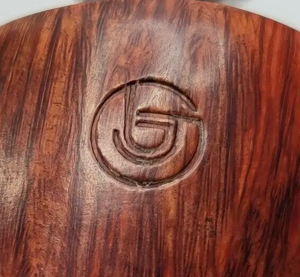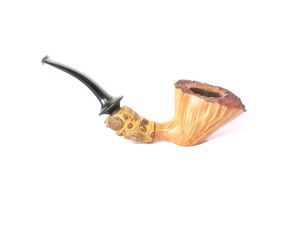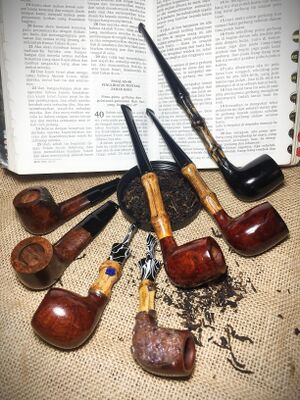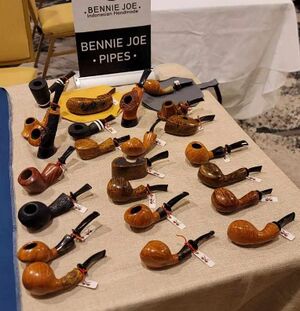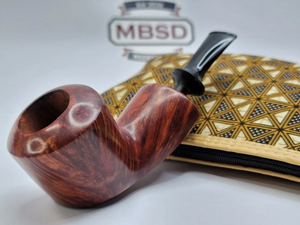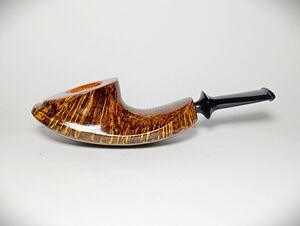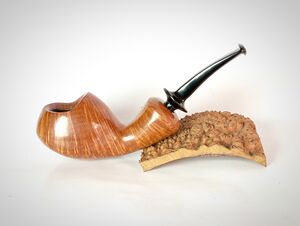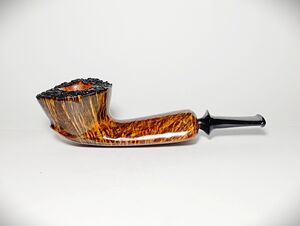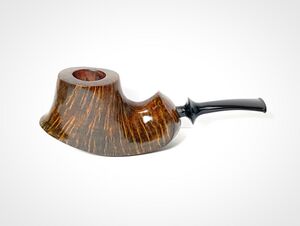Bennie Joe Pipes
Bennie Joe pipes are made by Prasetya Tri Wibowo (b. 1991), who lives in Jakarta, Indonesia.
Wibowo was educated as an architect, which he worked as for much of his early life. He began making pipes towards the end of the 2010s, but did so in his spare time, balancing pipe making with his job commitments.
During the Covid-19 pandemic and the ensuing lockdown measures enacted by governments worldwide, however, the property developer Wibowo was employed at was bankrupted due to economic pressures. Because of this, Wibowo chose to take on pipe making as a full-time career in 2020.
Wibowo was first brought to the craft by necessity. While he had been a pipe smoker for years, he did not have a large collection of pipes, and when his workhorse pipe – an old, estate Peterson he had bought at an antiques store – suffered an irreparable burnout, Wibowo was forced to find a new one for his regular rotation. Pipes are luxury items in Indonesia, and after finding that it would be less expensive to make a pipe himself than to buy a replacement, Wibowo decided to do just that, and spent the next eighteen months researching what he would need in order to make one.
Once he felt confident enough to begin making his pipes, Wibowo purchased seven ebauchon briar blocks with the intention of crafting simple billiards from them. After three months he was left with three billiards and, in his words, four ‘failures.’ But he was not dissuaded, and was fortunate to find a Facebook group for local pipe makers, many of whom were happy to give advice and to answer questions about the craft. It was through this group that Wibowo met Abdul Karim, maker of Karim Pipes, who provided further teaching regarding the tools and techniques of advanced pipe making.
When looking at his pipes, Wibowo’s list of pipe makers who have influenced him should come as no surprise. Along with his teacher, Karim, he admires figures such as Tom Eltang, Hiroyuki Tokutomi, Bo Nordh, and Michail Revyagin. He likes rounded pipe shapes, such as the apple, the egg, or the tomato, in part due to their ergonomic properties, such as their comfort in the hand and their ability to dissipate heat. He also makes many of the shapes that anyone familiar with artisan pipes should recognize, such as the blowfish and the fugu. This familiarity does not deter Wibowo, and he likens the interpretation of canonical shapes by pipe makers to an old adage about cooking: even when following the same recipe, every cook creates a different dish.
There is, however, something more significant that separates Wibowo from his influences, and which separates his interpretation of shapes in the pipe making canon from those of many others – that being how Bennie Joe pipes are made. Because Wibowo does not – at present – own a lathe, a bench drill, or a belt sander, his pipe making is a decidedly ‘low tech’ affair. While he does own an electric hand drill and hand grinder, the remainder of Wibowo’s pipe making is carried out using basic tools such as files and sandpaper. The reasoning behind this approach is more economical than philosophical – dedicated woodworking machinery is expensive, especially in certain parts of the world – but the results should give hope to other aspiring pipe makers who worry about making such investments.
While Bennie Joe pipes take inspiration from more modern artisan stylings, their execution is often more reminiscent of an earlier moment in the history of ‘hand made’ pipes, one which occurred in the 1960s and early 1970s in Denmark. This would be the transitional moment in Scandinavian pipe making, exemplified by pipe makers such as Karl Erik, the Skovbo og Nørding (SON) partnership, and Preben Holm’s works during his early career at Pibe-Dan, when pipe makers were first discovering the potentials of non-conventional pipe making procedures, but had not yet made the leap towards chasing ever-more extravagant ‘freehands.’ This was also a moment before the establishment of the new Scandinavian canon, whose shapes would soon stabilize around a chart to rival the classical Anglo-French one. As such, the question of what a pipe could look like was still very much open; it is this openness that Wibowo’s pipes, with their modest free-form shaping – likely a serendipitous product of the low-tech approach – is perhaps most reminiscent of.
Bennie Joe pipes are made with briar, ebonite, and often incorporate decorative elements such as bamboo. They have been sold by MBSD Pipes and Redeemed Pipes in the United States.
Gallery
Contact Information
Email: benniejoepipes@gmail.com Facebook www.facebook.com/bennie.joe.3 Instagram: www.instagram.com/bennie_joe

